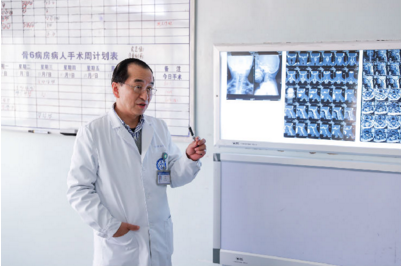
In November 2017, Professor Song Yueming’s surgical team from the Orthopedics Department of West China Hospital, successfully completed an odontoidectomy surgery, which was the first odontoidectomy case in the world finished by ultrasonic bone curette. A successful clinical outcome was achieved and the patient discharged in the past few days.
The patient, a 41 years old female, came to the hospital with a chief complaint of progressive weakness and numbness in her upper and lower limbs, especially on the right side. The symptom, which resulted from an accident injury, aggravated for two years. After admission, thorough examination was performed. The patient had congenital deformity in occipitocervical region and atlantoaxial dislocation. The dens moved upward obviously and caused severe spinal cord compression, which was called as “basilar impression” in nomenclature. Because of longtime atlantoaxial dislocation, atlantoaxial joint had fused. It was impossible to reduce atlantoaxial joint. In addition, dens caused severe spinal cord compression. So dens resection was the only choice to get spinal cord decompression. Otherwise, consequences would be disastrous. The patient may have paralysis, or even die.
Dens resection means a surgery near human life center. The dens, whose position is very deep, locates in the top of spine. This region is the place where respiratory and circulation center locates. During surgery, any carelessness may cause damage to vital center and bring complications. The traditional procedure is transoral approach. Dens resection is performed by opening the mouth with self-retaining retractor system. However, the infection risk of traditional procedure is very high, and patients need to stay in intensive care unit for a long time, which brings heavy economic burden. Another traditional procedure is to remove dens by the extreme lateral–transatlas approach using high-speed drill. But high-speed drill is likely to slip, and this region is the place where respiratory and circulation center locates. So it is very likely to had complications. This approach was first performed in West China hospital 20 years ago. However, it was abandoned due to high complication rate. For many years, such kind of patient was treated by longtime cervical traction and occipitocervical fusion. Nonetheless, without direct decompression of the spinal cord, patients got insignificant symptom improvement and poor quality of life.
In recent years, ultrasonic bone curette is widely used in orthopedic surgery. So Professor Song tried to use ultrasonic bone curette to resect the dens of the axis with vertebral column resection (VCR) technique. Ultrasonic bone curette, only causes damage to bone tissue by supersonic vibration, without the risk of vascular damage or spinal injury. VCR technique is a widely-used osteotomy technique in spine deformity, which requires complete excision of the vertebra from posterior bilaterally. To remove the dens with ultrasonic bone curette and VCR technique, thorough resection and decompression can be achieved.
The patient was sent to operating room at 2.00 pm October 25th. Using ultrasonic bone curette, the surgical team of Professor Song Yueming removed the dens bilaterally through posterior approach, and complete spinal cord decompression was achieved. In order to restore the stabilization of head and neck, iliac crest graft was harvested and fixed to occipital bone by screws. At 7.00 p.m., the surgery was successfully finished. Postoperatively, the patient showed significant improvement in motor function of right extremities and the muscle strength was improved to grade 3. The patient could raise the right lower extremity from the bed. In the future, after subsequent rehabilitation training, the patient may recover better and return to her previous normal life.